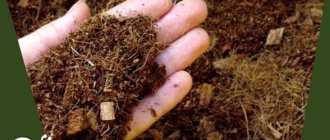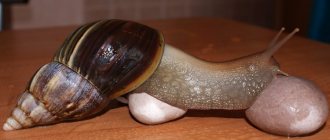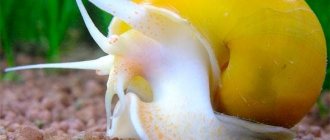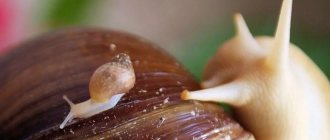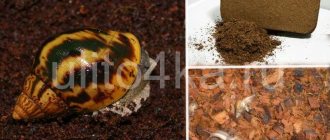Achatina snails are land mollusks. Originally from tropical countries. African mollusks cannot live in nature in our latitudes, so those who love exotic animals raise and keep large Achatina at home. What does a snail need for a comfortable stay? A cozy home, delicious food and proper care.
Choosing a container to contain Achatina
The snail is the only living creature on the planet that carries its home on its shoulders, but without a terrarium or container, it is not possible to keep an African guest at home.
A container for comfortable living of a mollusk must meet several requirements:
- the shape should not be round;
- the walls should be transparent or matte;
- do not use plywood or cardboard box;
- a lid is required;
- made from safe materials.
Terrarium for Achatina
The terrarium can be vertical or horizontal. A horizontal terrarium, with a large bottom area, low and wide, is more suitable for keeping Achatina. Achatina should not break when falling from a wall or ceiling. The terrarium can be purchased at a pet store or on the Internet. When purchasing, pay attention to what materials it is made of so as not to harm your pet’s health.
The volume of the terrarium should be 5 times the size of an adult snail. Simply put, at least 20 liters per individual.
The terrarium is always already equipped with a lid that will prevent the snail from leaving it on its own and traveling around your apartment. In terrariums, everything is already thought out for attaching a thermometer, hygrometer and thermal cord, so there should be no problems with all these necessary accessories.
But the only downside to the terrarium is its expensive price, so if you don’t have a large budget, look for used ones on markets and free bulletin boards. Also, the price of a terrarium depends on the materials used in its manufacture.
If it is glass, then its price is small, but the glass makes it heavy and fragile. If the terrarium is made of plexiglass, then its price is high, but it is light and not as fragile as glass. Many novice snail breeders use an old aquarium as a terrarium for Achatina.
Aquarium for snails.
You can keep the African snail in an aquarium, but it should not be round and its volume should be at least 20 liters. The aquarium should be rectangular in shape with a wide bottom.
Be sure to equip it with a glass or plexiglass lid on top so that the snail does not escape. Make holes in the aquarium for ventilation.
Cons of an aquarium:
- heavy as it consists of glass;
- fragile, if handled carelessly, you can get injured;
- it is inconvenient to drill holes in glass;
- If you buy, then a terrarium is better.
Food container for Achatina
Today, a plastic container is becoming increasingly popular as a house for snails. It is made from environmentally friendly materials, is sold in any volume, and the walls of the container are transparent, which gives us the opportunity to monitor the behavior of our pet. It also already has a lid, which is mandatory when keeping shellfish at home.
Achatina in a food container The plastic container is convenient to use, it is lightweight and easy to carry from room to bathroom. Plastic washes well and does not scratch, unlike glass and plexiglass.
You can easily install a thermometer, hygrometer and thermal mat in the container as needed. Make proper ventilation for snails yourself.
It is up to you to decide which container to choose for keeping Achatina snails. It is important that the conditions under which they stay in our homes are as close to natural as possible. Frequent mistakes of snail breeders.
Home decoration
The design of the “house” of mollusks occurs with the help of plants, both living and artificial, as well as various decorative elements. The latter must be made from natural materials that are environmentally friendly for the health of the pet. In addition, it is important that there are no sharp edges or surfaces that could cause injury to shellfish.
How to make proper ventilation
The snail does not need a lot of oxygen, but even it needs an influx of fresh air. The air dries the soil in the terrarium, preventing mold and unpleasant odors from forming. On the Internet, there are two opinions regarding ventilation in Achatina dwellings. Some argue that it is enough to make a few holes in the lid of the terrarium and this will be enough for a comfortable life for the mollusk.
If you notice that the soil is drying out quickly, seal several holes.
Others argue that air should not only enter the terrarium, but also exit. Proper air circulation is ensured by holes on the walls of the terrarium. On one side - at ground level, on the other side - just below the terrarium lid. The holes should be no thicker than a match.
If you have a terrarium for hamsters, seal half the holes on the lid to prevent the soil from drying out quickly.
Feeding regimen and diet
An important aspect of keeping giant snails is that if the pet does not get everything it needs, it will get sick and die. Achatina should not be given:
- acid;
- calcium;
- salt,
- sour foods, confectionery and flour products;
- potato;
- green tomatoes;
- sweet foods and drinks;
- smoked meats;
- roast.
In their natural environment, these snails eat almost everything - from rotting plants to citrus bark. They grind food with a tongue covered with spines with a keratinized surface. They do not refuse carrion, mushrooms, algae, and lichens. At home, Achatina is fed with melon, pumpkin, greens, salad plants, sunflowers, eucalyptus leaves, legumes, onions, potatoes, spinach, and young corn.
It is useful to give your pets shoots of cereals and vegetables, tops from beets and carrots. You can also diversify your pet’s menu with young birch, linden, apple or oak leaves, freshly squeezed juice from pumpkin, carrots, peach, pear.
It is worth noting that young animals of this breed love to eat living vegetation, while adults prefer rotting remains. Many owners have real picky eaters waiting for something “tastier.” But usually such behavior can be corrected, and, without waiting for a tasty bonus, Achatina begins to eat what the owner offered them.
Until recently, Achatina in Russia was truly exotic. Sellers quickly sold these overseas inhabitants, and the army of fans of giant snails grew steadily. Today, many people keep these mollusks and even produce offspring, which confirms that caring for them is not as difficult as it seems.
How to choose a place for a container with snails.
Direct sunlight is contraindicated for Achatina, so you can place the terrarium on a bedside table or shelf away from sunlight and drafts. Do not place the snails' home near a radiator or radiator, as they will get too hot and may die.
Decorate the container on both sides with fresh flowers or artificial plants, let it be a corner of exoticism and relaxation.
Where to put?
It is customary to place a tank for snails in a dark part of the room, where the sun's rays do not reach. Exposure to the sun can lead not only to a violation of the required level of humidity inside, but also to overheating of the creatures themselves and their further illness and death. It is also important to ensure that the aquarium is located away from drafts or radiators. The container must be firmly secured to the chosen location and must also be protected from pets. General cleaning will have to be done at least once every couple of weeks, so access to the tank will have to be kept simple. For cleaning, it is necessary to use the safest means possible, devoid of chemical components that are harmful to the health of Achatina.
How to set up a terrarium for a snail, see below.
Types of soil for snails
African snails cannot live without soil, since they sleep in it, lay eggs, and the soil helps maintain the necessary humidity in the terrarium, and also, if a snail falls off the wall or lid, the soil will prevent it from breaking. Examples of popular soils for snails.
Permitted soils
- Coconut substrate is an inexpensive and most common type of bedding for a terrarium. It holds moisture well and does not stain the walls and snail.
- Peat is an inexpensive type of soil. It holds moisture well, but it is better to use it in a mixture with other types of soil.
- Moss is an affordable and favorite type of bedding. Holds moisture and serves as a kind of indicator of humidity in the terrarium. The walls and snail are always clean. Prevents the appearance and reproduction of midges.
- The soil is good soil, it retains moisture and snails thrive in flower soil.
- Leaf litter serves as an independent and additional type of soil for the snail. She buries herself in it and rests during the daytime.
Prohibited soils
- Sand - scratches the shells and body of the snail, clogs the food system, which leads to the death of the mollusk.
- Sawdust is not Achatina’s favorite type of soil and is dangerous to its health.
- Stones are prohibited, as the snail can break on this type of bedding.
It is also not recommended to use clay and fatty loams as soil for African clams.
Lid. Aeration
Ventilation and humidity in an aquarium are of great importance, and the lid will affect these processes. The more aeration, the less humidity in the tank. You have to find a balance that works for your terrarium. Aeration is provided by holes in the lid or on the sides of the tank. If the box or glass aquarium does not have holes, you will have to make them yourself. If you are using a plastic lid, the easiest way is to cut a piece from it and make a “window”.
It is advisable that the hole be covered with a mosquito net to prevent fruit flies and other small insects from entering the terrarium. The mesh should be glued on the outside to ensure that the snail will not come into contact with the glue. Check the soil - it should be moist, but not wet like dirt. Tip: If the Achatina house is too wet, you may need several holes. If it is too dry despite constantly spraying water, you can try covering some of the existing holes with plastic sheeting.
Even if you manage to set up an aquarium for snails, it may be unexpected for other animals to settle in it. Some of them are even beneficial - for example, earthworms. They drain the soil, eat small particles of debris, and help with aeration. They also improve the quality of soil for plants and are harmless to snails and their eggs. So even if you are setting up a very simple terrarium, you may want to consider adding them. Otherwise, you can get by with clean soil, it will be even better.
It is recommended to place no more than one Achatina within one aquarium of 10 liters. These African snails are large enough to live in tight spaces. You can prepare a terrarium with a volume of 30 liters or more, and put two snails in there. But remember - they are fertile, and bear offspring several times a year. For the second pet, it is recommended to prepare another terrarium.
We decorate the terrarium with natural materials
You can add beauty and natural beauty to your landscape using bark, branches, pine cones and living plants.
The Achatina snail often burrows into the ground under branches or snags, so you can find interesting branches yourself in the forest, or you can buy them at a pet store. If you find a snag or branch, be sure to wash it and fry it for 10 minutes in the microwave.
A large piece of bark will add mystery to the terrarium, which you can also pick up in the forest or planting. It should also be treated before placing it in the Achatina dwelling. The snails will rest in an artificial shelter made from a piece of bark.
You can spread moss on top of the soil. Forest moss can be collected in the forest, but it should be soaked in cold water for 10 hours, then doused with boiling water and only then laid out in a terrarium like a carpet or made into fancy mounds.
Sphagnum moss is sold at pet stores and does not require additional processing. Serves as a beautiful green bedding. In addition to the moss, place a few spruce cones to give the forest landscape a complete look.
You can use half a coconut as an artificial shelter for the snail to rest during the day. Laying dry oak or birch leaves nearby.
Don't forget about living plants that thrive in moist soil.
- traditionalism;
- young;
- Money Tree;
- fern;
- ivy;
- mustard;
- barley;
- wheat.
Living plants will have to be renewed from time to time, as snails will eat them. Replacements will require driftwood and branches, bark and moss, all natural materials that lose their attractive appearance in a humid, warm environment. This way the decor in your terrarium will always be new.
Rules of care
- Cleaning and washing snails, containers and decorative elements. These actions are performed carefully so as not to damage the integrity of the body, container and decorative parts.
- The laid eggs are placed in moist soil to prevent them from drying out.
- Plant food that is pre-chopped is used as feed. It is also possible to introduce specialized food, which is sold in zoological stores.
If you properly arrange a tank for Achatina snails, you will be able to observe them for a long time. After all, these mollusks are distinguished by their good disposition and interesting behavior. Their maintenance does not require excessive effort. Therefore, they are suitable for both experienced and beginner aquarists.
Interesting video about setting up a terrarium for Achatina snails
AdminAuthor of the article
Did you like the article?
Share with your friends:
We equip the terrarium with artificial accessories
You can decorate the Achatina snail house not only with natural materials, but also with artificial accessories.
Shards from an old flower pot will serve as a shelter for the snail.
Place a plastic container with warm water in the terrarium, this will help maintain humidity in it and your pet will always be able to take water procedures in it.
Real flowers can be replaced with artificial ones, which will not be eaten by snails, will not wither and will always delight you with green leaves.
It is not advisable to use stones, porcelain and baked clay in a terrarium with snails if it falls off the ceiling or wall of the terrarium. If it hits a stone, clay or glass product, the consequences for it will be fatal.
Decorative elements
When creating a favorable environment for the inhabitants of an aquarium or terrarium, you can add particles of living nature to it. Certain types of living plants will not only look harmonious in an aquarium with snails, but also maintain the necessary microclimate in it .
Don't forget to place decorative elements
These include:
- fern;
- moss;
- ivy.
Given the flexibility of the latter plant, it is ideal for a small terrarium. And also such types of additional decor as fragments of pottery, unusual-looking sea stones, and mollusk shells will organically fit into this landscape.
Drinkers and feeders
A snail drinker most often plays the role of a bath or pool, so it must fully comply with safety requirements and be easy to wash and remove from the terrarium. But at the same time, the drinking bowl must be securely fastened inside the soil, otherwise it will easily move. It will be convenient to adapt disposable plastic dishes without sharp edges, polyethylene or silicone lids for jars for this purpose. Do not use glass, ceramic or any other hard types of materials.

